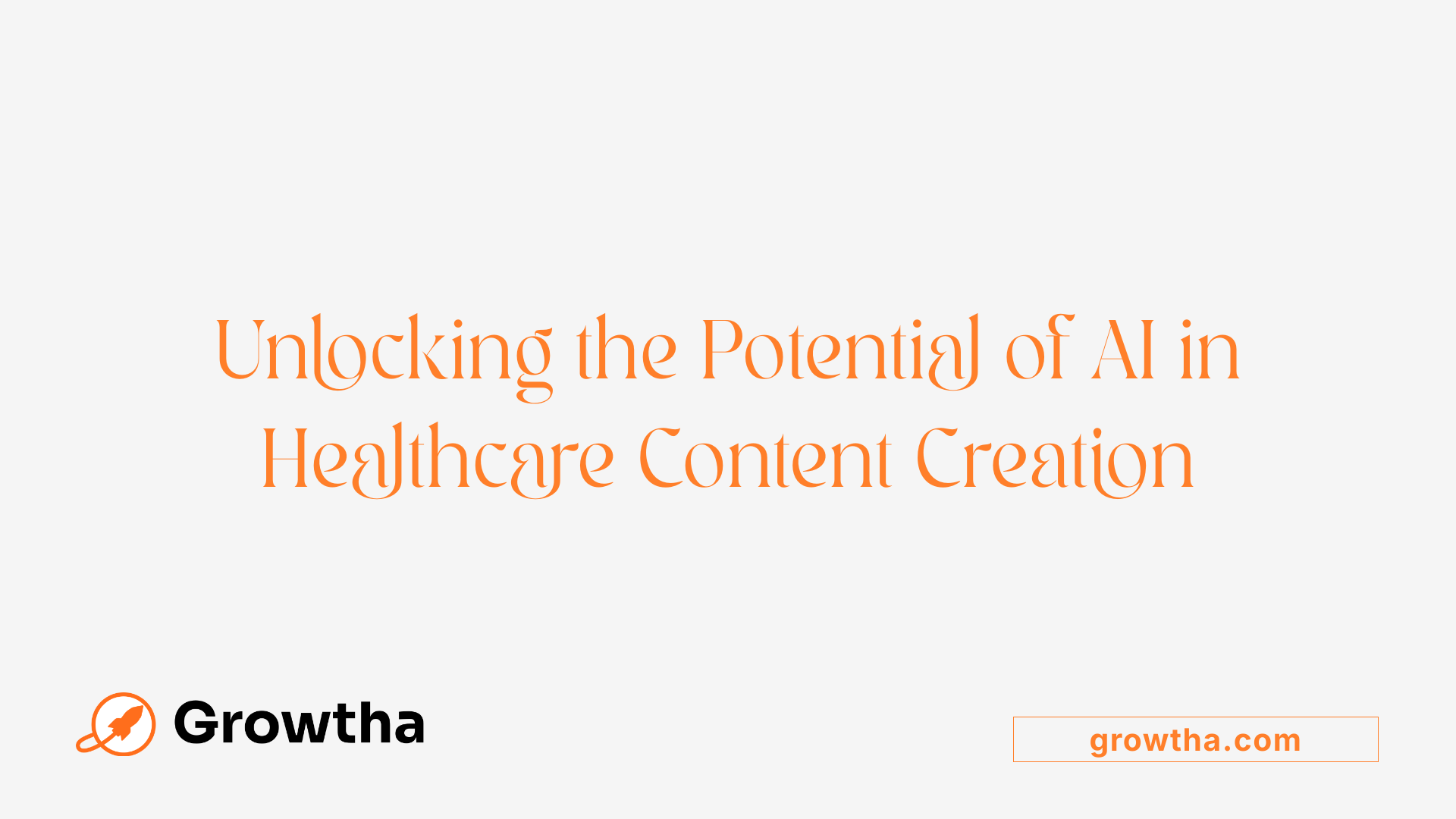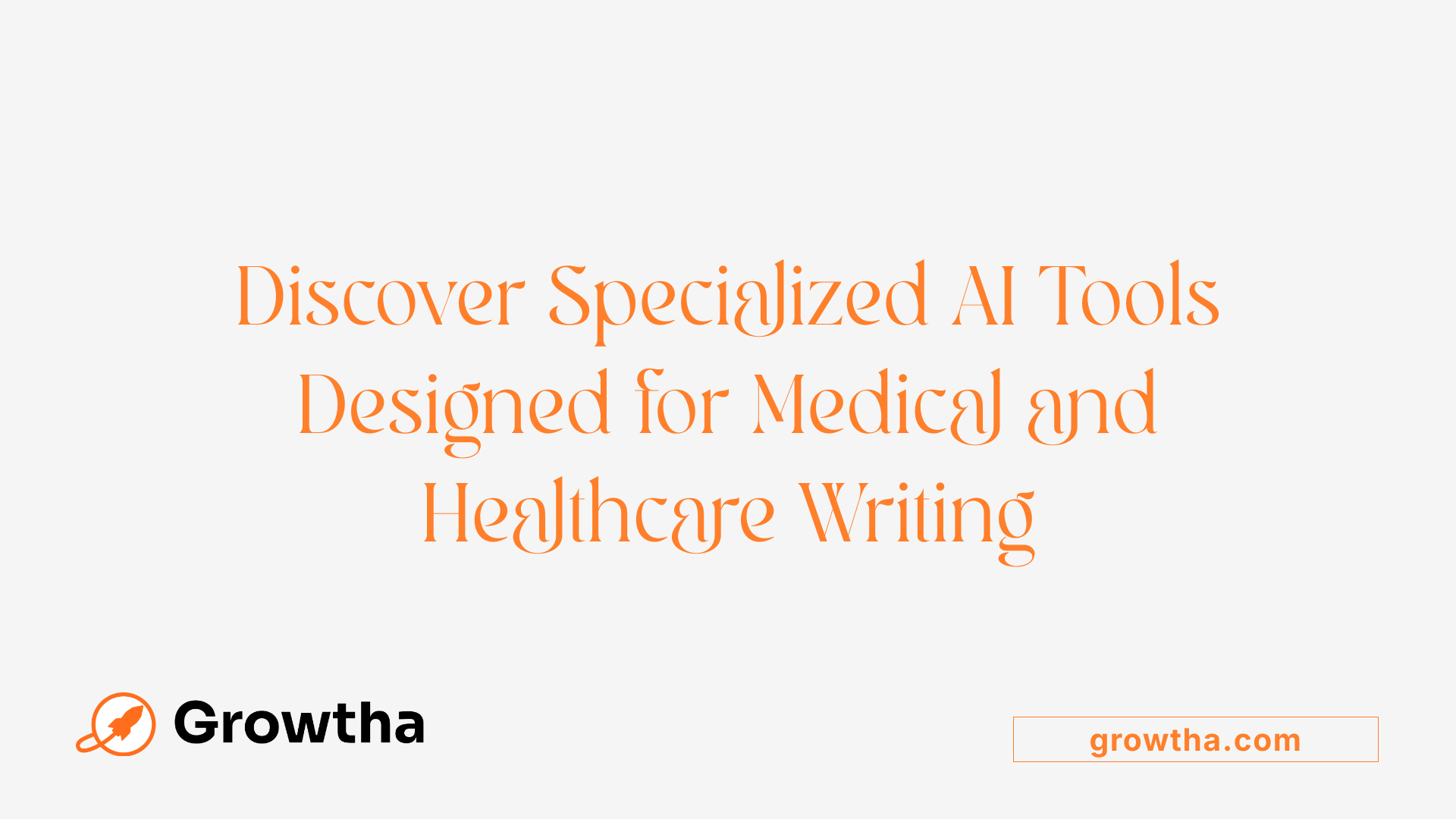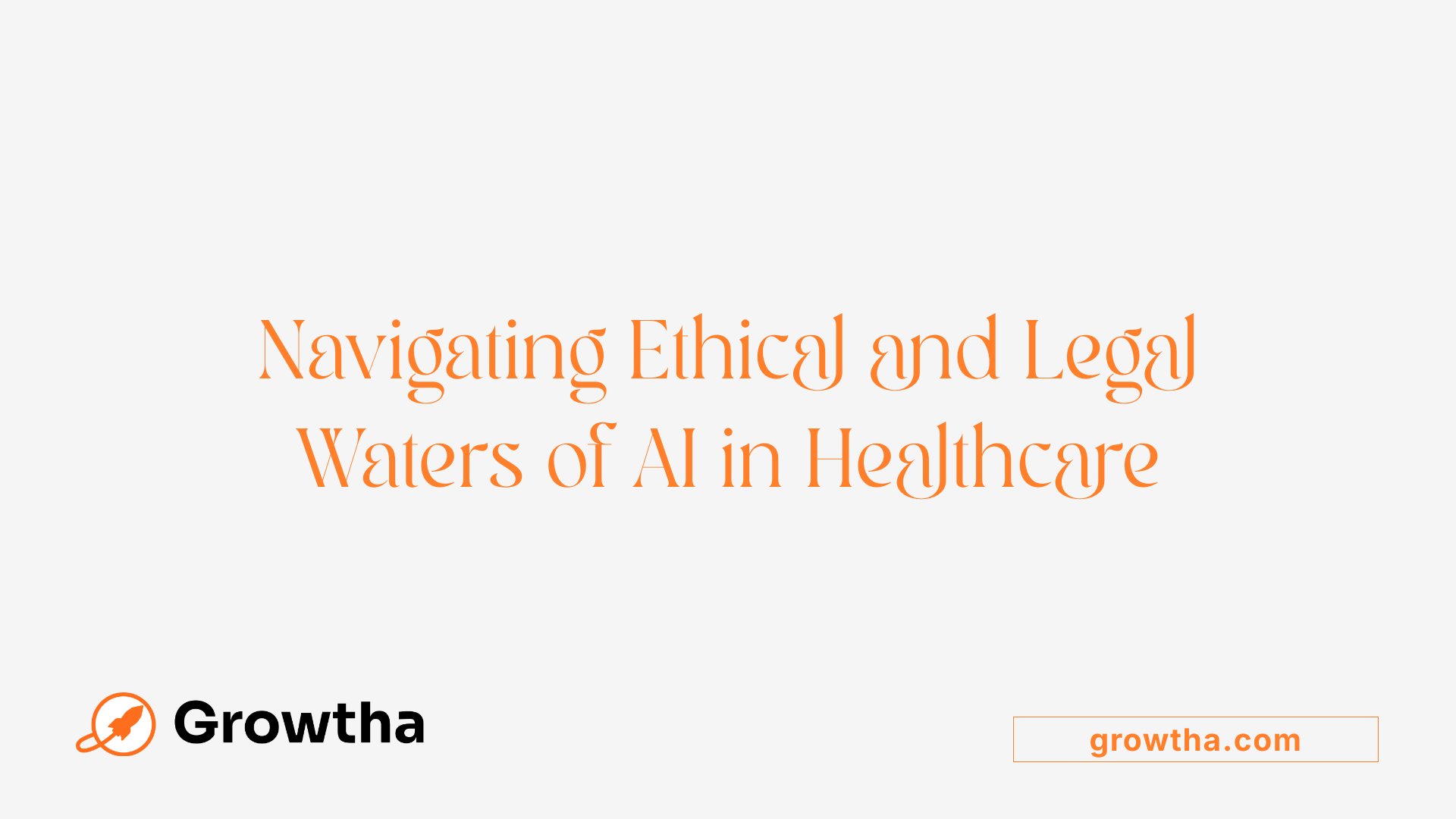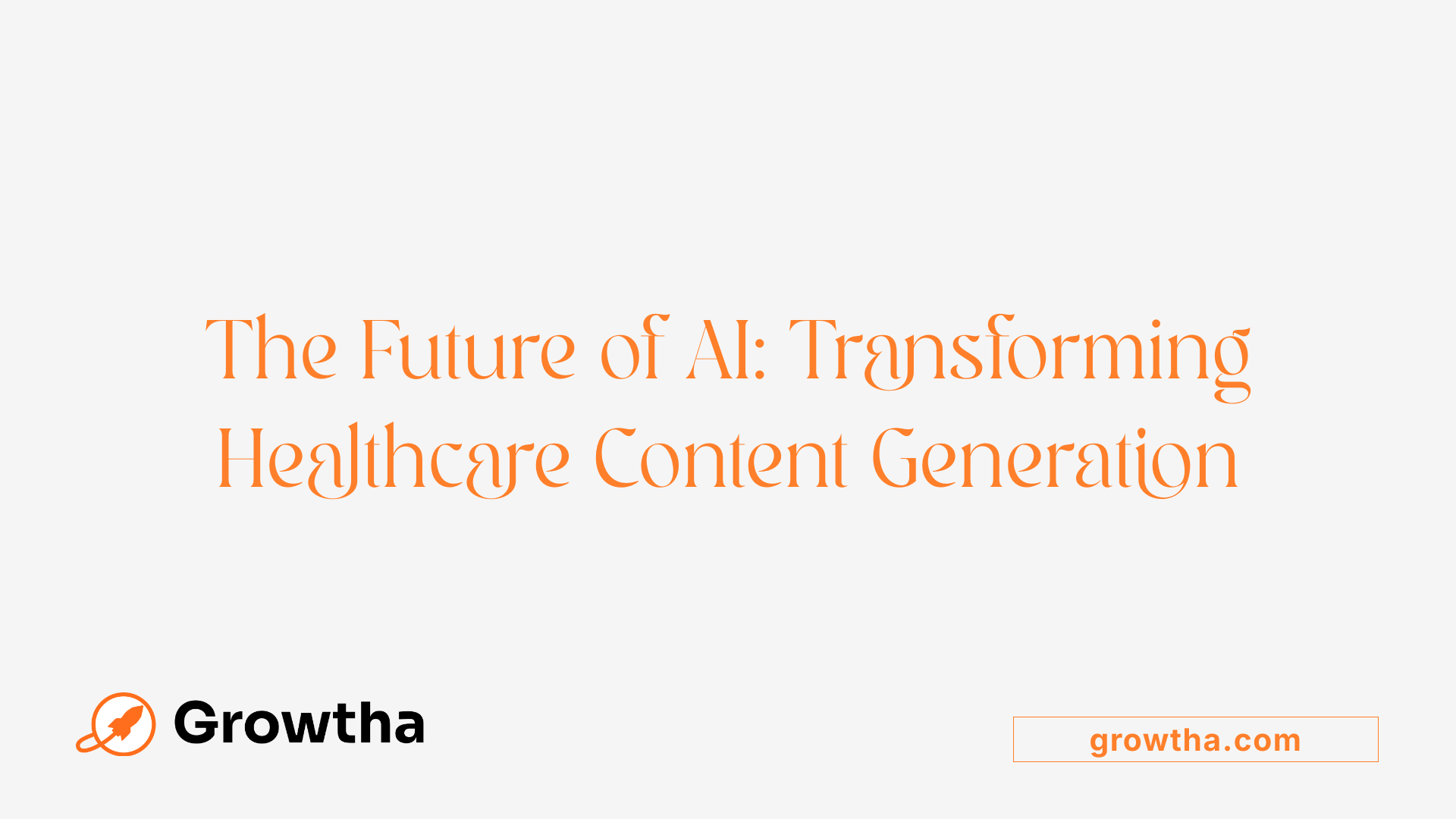Using ChatGPT and AI Tools for Healthcare Content Creation
Transforming Medical Communication with AI Innovations


Using ChatGPT and AI Tools for Healthcare Content Creation
Harnessing AI for Healthcare Content Development
The integration of advanced AI tools like ChatGPT into healthcare content creation marks a significant evolution in medical communication, education, and administrative efficiency. These technologies not only streamline workflows but also open new avenues for personalized patient engagement and clinical decision support. This article explores the multifaceted roles, benefits, challenges, and future prospects of AI in healthcare content generation, providing a comprehensive overview for practitioners, researchers, and healthcare marketers.
Applications and Benefits of AI in Healthcare Content Creation

What are the applications and benefits of using AI tools like ChatGPT in healthcare content creation?
AI tools such as ChatGPT have revolutionized how healthcare content is generated, making processes faster, more accurate, and more tailored to patient needs. These tools are capable of producing a wide range of materials, from in-depth medical articles and educational resources to concise summaries and translations. This enhances health literacy by providing patients and healthcare providers with clear, accessible information.
Clinicians benefit from AI-assisted support, which allows quick access to evidence-based data, clinical guidelines, and research summaries. This support accelerates decision-making, leading to more timely and accurate diagnoses. By automating routine documentation tasks, AI saves physicians considerable time, reduces errors, and frees up resources for patient care.
Personalized patient engagement is another major application. AI-powered chatbots and virtual assistants can communicate with patients in real-time, addressing questions about medications, procedures, or lifestyle changes. This tailored approach improves patient understanding, adherence, and satisfaction.
AI's role extends into diagnostics and medical imaging. Algorithms analyze radiological images, pathology slides, and other diagnostic data with high precision, aiding early detection of diseases such as cancer and diabetic retinopathy. AI also accelerates diagnostic workflows and reduces the likelihood of oversight.
In terms of healthcare administration, AI streamlines tasks like scheduling, billing, claims processing, and compliance reporting. These efficiencies reduce administrative burdens, cut costs, and enable healthcare providers to focus more on clinical activities.
Broadly, the benefits of integrating AI tools into healthcare content creation include enhanced clinical accuracy, improved patient communication, accelerated workflows, and the development of innovative therapies. As technology evolves, AI’s potential to deliver safer, more personalized, and efficient healthcare continues to grow, transforming both clinical practice and medical research.
Technical Aspects of AI in Healthcare Content Generation
What are the technical aspects of AI used in healthcare content creation?
The technological foundation of AI-driven healthcare content generation relies on sophisticated algorithms and models that interpret and produce medical information with accuracy and efficiency. Central to this are natural language processing (NLP), machine learning (ML), and deep learning (DL).
NLP enables the understanding and generation of human-like text, allowing AI tools to summarize research, craft patient communication, and translate medical jargon into accessible language. ML models learn patterns from vast datasets to improve content relevance over time, while DL, a more complex subset of ML, employs neural networks that mimic human brain structures to analyze complex data such as medical images and genomic sequences.
Training these systems involves large, diverse datasets sourced from electronic health records (EHRs), medical literature, imaging repositories, and genomic databases. These datasets are multidimensional, including structured data (like lab results), unstructured notes, and visual data, all of which contribute to creating robust models.
In medical imaging analysis, convolutional neural networks (CNNs) play a crucial role. CNNs excel in detecting patterns in radiology scans and pathology slides, aiding in diagnosis, treatment planning, and research. Meanwhile, large language models (LLMs) like GPT-4 facilitate the generation of clinical notes, summarization of research literature, and extraction of relevant information from vast texts.
Ensuring the effectiveness of AI tools in healthcare also involves validation processes. This includes rigorous testing for accuracy, bias, and completeness, often through clinical trials or pilot programs with stakeholder engagement, including clinicians, researchers, and patients. This collaborative validation helps address ethical issues, data security, and compliance with regulations.
Finally, deploying AI solutions responsibly requires strict adherence to standards for security, privacy, and reliability. Healthcare organizations must implement safeguards to protect sensitive patient information, ensure transparency in AI decision-making processes, and establish continuous monitoring systems to maintain high standards of performance and trust.
Overall, the integration of NLP, ML, and DL with high-quality training data and validation processes forms the backbone of AI's capability to transform healthcare content creation, supporting clinical practice and advancing medical knowledge.
Efficacy of AI in Healthcare-Related Material Production
How effective are AI tools in producing accurate healthcare-related materials?
AI tools like ChatGPT and other large language models have shown considerable promise in generating healthcare-related content. These tools can assist in creating articles, patient education materials, social media posts, and clinical summaries efficiently, significantly reducing the time typically required for manual content development.
In terms of clinical accuracy, AI systems have achieved high levels of sensitivity and specificity in specific diagnostic applications such as medical imaging analysis and symptom interpretation. For instance, AI models have performed better than some human experts in certain diagnostic tasks, enhancing reliability in imaging-based assessments. They also excel in generating preliminary research summaries, literature reviews, and data insights, which help healthcare professionals stay current with medical advancements.
Nevertheless, the accuracy of AI-generated content hinges on responsible validation. Proper oversight by qualified medical professionals is essential to verify facts, correct biases, and eliminate misinformation. AI tools are most effective when used as supportive resources rather than sole sources of truth. Combining AI efficiencies with expert review creates a trustworthy model for healthcare information dissemination.
What are the main challenges in utilizing AI for medical content?
Despite their advantages, AI tools face challenges like data bias, hallucinations (fabrication of plausible but incorrect information), and a lack of transparency. Biases embedded in training datasets can lead to skewed outputs, especially affecting minority groups or specific populations. Hallucinations or false factual claims, which AI sometimes generates due to limited or outdated training data, pose risks to accuracy.
Moreover, issues like data privacy concerns, potential legal liabilities, and ethical considerations regarding misinformation make cautious deployment necessary. Without continuous oversight, AI-generated content could propagate inaccuracies, potentially impacting patient safety and healthcare outcomes.
How can healthcare providers overcome these challenges?
To maximize AI efficacy while minimizing risks, best practices include rigorous validation of AI outputs, ongoing human oversight, and strict protocols for fact-checking. Medical professionals should critically review AI-generated content, correcting inaccuracies or biases before publication or dissemination.
Implementing regular monitoring systems to detect errors and biases, along with transparent documentation of AI assistance, reinforces accountability. Educating healthcare staff about AI capabilities and limitations ensures responsible usage. Additionally, ongoing research and development should focus on refining AI models with diverse, representative datasets to reduce bias and increase reliability.
Monitoring and oversight best practices
Effective oversight involves a multidisciplinary approach, integrating AI developers, clinicians, and ethicists. Standard operating procedures should mandate validation steps for all AI-generated healthcare materials. Setting up audit trails and keeping logs of AI usage helps in ongoing assessment and accountability.
Training programs for healthcare workers on AI tools improve understanding of appropriate application and limitations. Moreover, maintaining compliance with regulatory standards and guidelines—like those from the FDA or WHO—ensures responsible AI integration.
In summary, while AI technologies like ChatGPT demonstrate high potential in producing accurate healthcare-related materials, their success depends on careful validation, ongoing oversight, and adherence to ethical standards. When integrated thoughtfully, AI becomes a powerful adjunct in healthcare communication, education, and clinical decision support, ultimately enhancing patient care and medical research.
Specialized AI Tools for Healthcare and Medical Writing

Are there specialized AI tools designed specifically for healthcare and medical writing, and how do they compare?
Yes, numerous AI tools have been developed to meet the unique demands of healthcare and medical writing. Unlike general AI models like GPT-4 or ChatGPT, which are trained on diverse datasets, these specialized platforms focus on the intricacies of medical terminology, regulatory standards, and patient safety.
One leading example is WRITER’s platform, which offers AI agents tailored specifically for medical use. These tools facilitate tasks such as generating medical publications, creating comprehensive value dossiers, and summarizing complex electronic health records (EHRs). Their design ensures high levels of accuracy, safety, and compliance—crucial for clinical documentation and decision-making.
An important feature of these specialized AI systems is their foundation on healthcare-specific large language models, such as Palmyra Med. These models are trained on curated medical datasets, including scientific literature, clinical guidelines, and regulatory documents. This targeted training results in outputs that are more scientifically reliable, referencing correct citations, and aligning with medical standards.
Compared to general models, healthcare-focused AI tools outperform in critical areas like precision and reliability. For example, they are less prone to hallucinations—fabricated or plausible but false information—which is a known limitation of broad-language models.
Workflow automation is another advantage. These platforms often include no-code and low-code tools that allow healthcare professionals to customize their workflows without extensive programming skills. They can automate routine documentation, compliance checks, and even complex tasks like medical review processes.
Moreover, these specialized solutions are built with privacy and security in mind. They adhere to strict regulatory standards such as HIPAA in the United States and GDPR in Europe, ensuring patient data confidentiality and organizational compliance.
In summary, healthcare-specific AI tools are designed to address the unique challenges of medical writing and documentation. They offer improved accuracy, safety, and compliance compared to general AI models, making them invaluable assets for clinicians, researchers, and healthcare organizations seeking to leverage AI efficiently and responsibly.
Ethical and Legal Considerations in Healthcare AI Use

What are the limitations and ethical considerations of using AI in healthcare communication?
Implementing AI tools like ChatGPT in healthcare settings presents both promising opportunities and significant challenges. Among the main limitations are the risk of inaccuracies and the presence of biases that may originate from training datasets that are not fully representative of all patient populations. This can lead to biased recommendations or information that may negatively impact marginalized groups. The 'black-box' nature of advanced AI models makes transparency difficult, as it is often unclear how a specific output was generated, which can hinder clinicians' and patients' understanding and trust.
Ethically, safeguarding patient privacy is paramount. AI systems must incorporate robust data security measures to prevent breaches of sensitive health information. Informed consent is another critical aspect—patients should be aware when AI tools are involved in their care and understand how their data is used. Accountability also plays a vital role; developers, healthcare providers, and institutions share responsibility for the decisions and recommendations generated by these systems.
Legal regulations further shape AI use in healthcare. Compliance with frameworks like the Health Insurance Portability and Accountability Act (HIPAA) in the U.S. and the General Data Protection Regulation (GDPR) in Europe is mandatory. These regulations enforce strict standards on data privacy, security, and patient rights.
The ethical deployment of AI requires continuous oversight, including testing for fairness and bias and transparency about AI capabilities and limitations. Failure to address these considerations can exacerbate health disparities, undermine patient trust, and lead to legal repercussions. Implementing clear policies on disclosures, attribution, and accountability ensures that AI remains an aid—rather than a substitute—for human judgment and compassion.
| Aspect | Policy/Standards | Important Notes |
|---|---|---|
| Bias mitigation | Regular audits, diverse datasets | Reduce disparities, ensure fair treatment |
| Data privacy and security | Encryption, access controls | Prevent breaches, protect sensitive info |
| Transparency and explainability | Model interpretability, reporting | Promote understanding and trust |
| Disclosures and attribution | Explicit acknowledgment | Clarify AI’s role in care or research |
| Accountability and oversight | Human oversight, ethical review | Maintain responsibility for outcomes |
| Legal regulations (HIPAA, GDPR) | Compliance with laws | Ensure lawful, ethical data handling |
While AI continues to evolve, integrating these ethical and legal principles into everyday practice is essential. This guarantees that healthcare AI technologies uphold the highest standards of patient safety, fairness, and transparency, fostering trust and advancing equitable healthcare delivery.
Future of AI in Healthcare Content Generation

How is AI transforming future trends and innovations in healthcare content generation?
AI is revolutionizing how healthcare content is created and utilized, paving the way for more accurate, personalized, and comprehensive medical documentation and educational materials. Advances in natural language processing (NLP) enable AI to analyze vast amounts of research papers, clinical notes, and patient records swiftly, transforming complex medical jargon into clear, accessible language suitable for diverse audiences.
Generative AI tools are increasingly capable of producing detailed clinical summaries, tailored treatment plans, and risk assessments with minimal human input, streamlining clinical workflows and reducing cognitive load on healthcare providers. This automation not only improves efficiency but also helps combat burnout among clinicians by handling routine documentation tasks.
Innovation in drug discovery, clinical trial design, and scientific research is accelerated by AI's ability to process and synthesize large datasets rapidly. For instance, AI models can identify potential drug targets and predict their effectiveness, speeding up the development of new therapies.
Furthermore, AI-driven content generation fosters a more dynamic exchange of information, supporting continuous medical education, patient engagement, and informed decision-making. As the technology evolves, healthcare content will become increasingly personalized, contextual, and accessible, significantly improving health literacy and patient outcomes.
In summary, AI's role in healthcare content generation is set to expand, facilitating the creation of high-quality, individualized resources that enhance scientific understanding, patient care, and medical innovation.
Responsible AI Use and Best Practices in Healthcare
How can healthcare professionals ensure ethical and responsible use of AI tools?
Healthcare professionals have a critical role in ensuring AI tools are used responsibly and ethically in medical settings. First, transparency is fundamental. Providers should understand and communicate how AI systems generate their outputs, whether through explainable AI models or clear documentation. This builds trust among clinicians, patients, and stakeholders.
Second, verification and validation are essential steps. AI outputs must be rigorously tested through clinical validation studies, ensuring their recommendations are accurate and reliable. Ongoing monitoring also helps detect performance deviations over time, especially as data evolves.
Protecting patient privacy and data security is paramount. Adherence to regulations such as HIPAA in the U.S. and GDPR in Europe is necessary. Techniques like data anonymization, encryption, and controlled access can safeguard sensitive information.
Bias mitigation is another priority. Healthcare providers should advocate for diverse, representative data sets to train AI models, helping reduce disparities. Monitoring outcomes across different demographic groups can identify unintended biases, prompting necessary adjustments.
Furthermore, employing explainable AI models allows stakeholders to interpret decision pathways, fostering greater trust and accountability. Clear documentation of AI capabilities and limitations should accompany deployment.
Professional responsibility also involves critical assessment of AI tools—questioning their safety, efficacy, and ethical considerations. Engagement with regulatory bodies like the FDA and standards organizations such as HITRUST guides safe implementation.
Informed consent procedures should reflect AI involvement, informing patients about the role AI plays in their care while respecting their rights to understand and opt-out when appropriate.
Finally, continuous education is vital. Healthcare providers must stay updated with the latest legal, ethical, and technological developments related to AI. This lifelong learning ensures that AI integration enhances patient outcomes without compromising standards of care.
Why are protocols for validation and verification necessary?
Protocols for validation and verification act as quality assurance measures. They confirm that AI systems function correctly within specific contexts, providing accurate and consistent outputs. These protocols involve clinical testing, peer review, and real-world pilot programs. They help prevent errors, reduce risks of misinformation, and ensure compliance with regulatory requirements.
What ethical standards should be followed?
Adhering to ethical standards involves ensuring patient safety, privacy, fairness, and transparency. AI use should augment, not replace, human judgment. Patients should be informed about AI tools involved in their care and consent should be obtained. Stakeholders must strive to prevent discriminatory outcomes and address biases proactively.
How can monitoring and evaluation improve AI integration?
Ongoing monitoring and evaluation enable prompt identification of issues such as inaccuracies, biases, or system failures. Regular audits, user feedback, and performance metrics help refine AI tools, making them safer and more effective. This continuous oversight aligns with ethical responsibilities and fosters trust in AI-assisted healthcare.
| Aspect | Description | Implementation Strategies |
|---|---|---|
| Transparency | Clear understanding of AI decision processes | Use explainable models, documentation |
| Validation | Confirm AI accuracy in clinical settings | Rigorous testing, pilot studies |
| Privacy & Security | Protect patient data | Encryption, anonymization, access controls |
| Bias & Fairness | Ensure equitable outcomes | Diverse data, outcome analysis |
| Education | Keep professionals up-to-date | Continuous training, workshops |
| Monitoring | Detect and fix issues over time | Performance audits, feedback channels |
By following these practices, healthcare professionals can harness AI’s potential while safeguarding ethical standards, ultimately advancing patient care responsibly.
Integrating AI into Healthcare Systems and Workflow
How can healthcare professionals ensure ethical and responsible use of AI tools?
Healthcare professionals play a vital role in ensuring AI tools are used ethically and responsibly within healthcare systems. One of the first steps is maintaining transparency about how AI systems generate their recommendations and decisions. This involves understanding the algorithms' background, limitations, and the data they are trained on.
A critical part of responsible AI use is thoroughly verifying the accuracy and reliability of these tools. Clinical validation through trials and continuous monitoring helps ensure AI outputs are safe and effective in real-world settings.
Protecting patient privacy and data security is paramount. Compliance with regulations such as HIPAA (Health Insurance Portability and Accountability Act) and GDPR (General Data Protection Regulation) is essential. Techniques like data encryption, anonymization, and strict access controls should be employed to safeguard sensitive health information.
To address biases and promote fairness, healthcare providers should advocate for diverse data collection that represents different populations. Regularly monitoring AI outcomes for disparities helps identify and mitigate potential biases.
Developing explainable AI models is also crucial. These models allow stakeholders—clinicians, patients, and regulators—to interpret how decisions are made, fostering trust and accountability.
Healthcare professionals must critically evaluate AI tools' safety, efficacy, and ethical implications before and during their use. Engaging with standards and guidelines from authoritative organizations such as the FDA (Food and Drug Administration) and HITRUST ensures alignment with best practices.
Ultimately, responsible AI integration involves informed consent processes where patients are aware of AI's role in their care, accountability for decision-making, and ongoing education to stay updated on evolving legal, ethical, and technological landscapes.
Challenges and Limitations of AI in Healthcare Content Creation
What are the limitations and ethical considerations of using AI in healthcare communication?
While AI tools like ChatGPT hold significant promise for transforming healthcare communication, they come with notable limitations and ethical concerns. One primary challenge is the potential for inaccuracies and hallucinations, where AI generates plausible but incorrect information. Such errors can mislead patients or healthcare providers, leading to misguided decisions.
Biases present in training datasets also pose a risk. If datasets do not adequately reflect diverse populations, the AI's outputs may unintentionally reinforce stereotypes or discriminate against marginalized groups, affecting fairness and equity in healthcare.
Data privacy and security are critical issues. AI systems process sensitive health data, increasing risks of data breaches or misuse if robust safeguards are not enforced. Ensuring patient confidentiality requires strict adherence to privacy laws like HIPAA and continuous monitoring of data handling practices.
Overreliance on AI can lead to reduced human oversight, potentially resulting in job displacement for certain administrative or documentation roles. While AI streamlines many tasks, it should complement rather than replace human judgment, particularly in nuanced patient interactions.
Transparency and explainability are often limited with complex AI models, creating 'black-box' issues that hinder understanding of how specific outputs are generated. This lack of clarity can reduce trust among users and complicate accountability.
Regulatory gaps also exist. Many AI tools operate in a gray area without comprehensive standards governing their deployment, which raises questions about liability, quality control, and long-term safety.
In summary, although AI enhances healthcare communication efficiency, addressing these limitations and ethical considerations is essential. Rigorous oversight, transparent algorithms, secure data management, and ongoing validation are necessary to harness AI's benefits responsibly without compromising patient safety, fairness, and trust.
| Limitation/Concern | Description | Impact on Healthcare |
|---|---|---|
| Inaccuracies and Hallucinations | AI generates incorrect or plausible-sounding but false information | Risk of misinformation, misdiagnosis |
| Biases in Datasets | Data used to train models may lack diversity, leading to unfair outcomes | Discrimination, reduced trust in AI tools |
| Data Privacy and Security Risks | Sensitive health data may be exposed or misused | Breaches, loss of patient confidentiality |
| Overreliance and Job Displacement | Dependence on AI may diminish human roles in healthcare workflow | Workforce reduction, diminished personal care |
| Lack of Transparency and Explainability | Difficulty understanding AI decision-making processes | Reduced user trust, accountability issues |
| Regulatory Gaps | Absence of comprehensive legal frameworks for AI use | Unregulated deployment, liability concerns |
Understanding these challenges is crucial for integrating AI into healthcare responsibly. Continuous evaluation, ethical guidelines, and technological improvements are needed to mitigate these issues and protect patient interests.
Future Perspectives and Responsible Implementation
The future of AI in healthcare content creation holds vast promise for enhancing medical documentation, education, and patient engagement through innovative, personalized solutions. As AI technologies advance, multidisciplinary collaboration between clinicians, technologists, and ethicists becomes essential to address challenges like bias, transparency, and data privacy. Adhering to evolving guidelines from regulatory bodies ensures responsible deployment, fostering trust and safety. Emphasizing human oversight, ethical standards, and continual validation will enable the healthcare sector to harness AI’s full potential responsibly, ultimately improving healthcare quality, accessibility, and outcomes worldwide.
References
- ChatGPT Utility in Healthcare Education, Research, and Practice
- ChatGPT in Healthcare: Top 17 Use Cases in the Industry
- Artificial Intelligence (AI)-Generated Healthcare Content
- ChatGPT and Artificial Intelligence in Medical Writing
- How Healthcare Marketers Can Benefit from ChatGPT and AI
- How Reliable are AI and ChatGPT in the Medical Field? - AFMC.org
- ChatGPT in healthcare: A taxonomy and systematic review
- How Will AI Tools Like ChatGPT Change Healthcare? - Osmosis Blog
- ChatGPT for Healthcare: Transforming Patient Care - DataCamp
- Application of artificial intelligence and ChatGPT in medical writing







